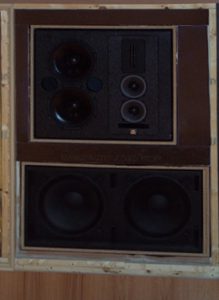University of Massachusetts, Lowell
Bag End Plays Key Role in University’s Acclaimed Critical Listening Studio
The Music Department at the University of Massachusetts Lowell has a unique claim to fame: it is one of the few schools in the nation to offer a Master’s Degree in Sound Recording Technology. But beyond that, the school provides students with some of the most sophisticated recording facilities anywhere in the world.
“Our facilities – in particular our Critical Listening and Recording Studio – don’t just represent state-of-the-art,” said Bill Carman, the program’s associate director, who is in charge of the facilities, “This room really defines the new state-of-the-art.”
The $500,000 critical listening room, recently rated one of the top five rooms in the industry by a panel of sound engineers, features a 5.1 sound system and serves as both a recording studio and laboratory. “We ask students to identify and quantify by ear, specific aspects of sound, a necessary component of recording any music, whether a complex orchestral score or a commercial jingle,” Carman said.
Officially known as Room 114 in Durgin Hall, on the school’s South Campus, the Critical Listening and Recording Studio is designed to be a super accurate listening and monitoring environment in either stereo or various surround formats for critical listening and aural analysis of recordings, as well mixing and mastering in surround. Because of the high level of accuracy afforded by the room, the performance of audio equipment can also be readily observed and measured.
Dr. William Moylan, chairman of the UMass Lowell Music Department, told the Lowell “Sun” newspaper the experience in the room is “being able to listen to sound and describe it in a way that addresses the substance of the sound.”
The room is also a perfect setting as a multitrack recording environment, incorporating four separate spaces including the main live room with variable acoustics, an isolation booth and two amp closets. The studio also includes multimedia projection capabilities to aid in lecture classes, demonstrations or to provide mix-to-picture support.
 Creating the foundation for the room’s 5.1 surround sound system is a pair of Bag End D18E-I dual 18-inch subwoofer systems controlled by a Bag End INFRA signal processor and powered by Stage Accompany amplifiers. The D18E-I subwoofer system features extended flat frequency response down to 8 Hz. in a relatively small enclosure (44 inches by 22½ inches wide by 18½ inches deep).
Creating the foundation for the room’s 5.1 surround sound system is a pair of Bag End D18E-I dual 18-inch subwoofer systems controlled by a Bag End INFRA signal processor and powered by Stage Accompany amplifiers. The D18E-I subwoofer system features extended flat frequency response down to 8 Hz. in a relatively small enclosure (44 inches by 22½ inches wide by 18½ inches deep).
The designer of the room, Bob Alach, chief designer for Alactronics, a Massachusetts-based design and installation provider, said he chose Bag End subs because of their clarity and faithfully accurate reproduction of the bass range.
Other components of the system include SLS 1266 and 1065 monitors, an EMM Labs Switchman III surround controller and an Integra DVD-A/SACD player. Mixing and mastering is accomplished through a mobile production system that includes a Steinberg Nuendo DAW, Yamaha DM2000 console, TC Electronix System 6000, Genex GX9000 HD recorder and a Merging Technologies Pyramix 8-channel DSD/DVD-A workstation. Recording is facilitated via 48 mic lines, a Furman 6-channel cue system and two-way video communications.
All the systems in the Critical Listening room, together with tracking in the Multitrack Recording Studio (Room 213) and editing in Room 223, are integrated via a new fiber channel SANmp Pro Storage Area Network from Studio Network Solutions.
For more than a century, the University of Massachusetts Lowell has been educating students to work in the real world, solve real problems and help real people. The University began as the Lowell Normal School, founded in 1894 to prepare students to become teachers, and the Lowell Textile School, founded in 1895 to train technicians and managers for the textile industry. Over the next 75 years, both institutions extended their offerings to meet the growing needs of the region. Lowell State and Lowell Tech, as they were then known, merged in 1975 to form the University of Lowell. In 1991, the campus became part of the University of Massachusetts system.
Located in the historic industrial city of Lowell, 25 miles northwest of Boston, the campus spans more than 125 acres along the Merrimack River. More than 12,000 resident and commuter students of all backgrounds pursue bachelor’s, master’s, and doctoral degrees as well as professional certificates in the arts, humanities and sciences; education; engineering; health and environment; and management.
With the rush of new technologies that have revolutionized the recording industry in recent years, and the opportunities that new media are opening up for recording professionals, a higher level of training and education in music, media, and technology is now required for any meaningful employment, even at entry level.
The Sound Recording Technology program at UMass Lowell is one of the few programs in the United States offering this course of study, and provides the motivated student with the practical and theoretical background needed for success in the industry. Starting a career in audio recording has traditionally involved training through an informal apprenticeship system.
The goal of the SRT program is to produce a musically sophisticated and sensitive professional, with sufficient technical knowledge to excel in today’s production industry and to easily keep pace with its rapidly changing technology. The program combines studies in physics, electrical engineering, computer science, and advanced mathematics, with traditional studies in music and at least nine courses in the art and technology of recording.


